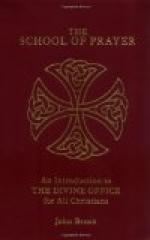The first clear evidence of a division of the Psalter for use in the Western Church is found in the work of St. Benedict (480-543). He had spent his youth near Rome, and keeping his eye on the Roman usage he assigned the Psalms to the various canonical hours and to different days of the week. The antiphons he drew from existing sources, and of course the canonical hours were already in existence. In his arrangement, the whole Psalter was read weekly, and the whole Bible, with suitable patristic selections, was read every year. He also arranged the Sunday, Festal and Ferial offices. For the recitation of the offices of a saint’s day, St. Benedict arranged that the Matins shall have the same form as a Sunday office—i.e., three nocturns, twelve lessons and responsories, but the psalms, antiphons and lessons are proper to each saint. This arrangement interrupted the weekly recitation of the whole psalter, and caused great difficulty in later times; for when the feasts increased in number the ferial psalter fell almost into complete disuse.
St. Benedict’s arrangement of the psalms and his other liturgical regulations spread rapidly, but the Roman secular office never adopted his arrangement of the psalms, nor his inclusion of hymns, until about the year 1145. In some details each office shows its independent history. It is a matter of dispute among liturgists whether Prime and Compline were added to the Roman secular office through the influence of the Benedictines (Baudot, The Roman Breviary, pp. 19-26).
The period following the death of St. Benedict in 543 is a period of which little is known. “We repeat with Dom Baumer (vol. i., pp. 299-300) that the fifth century, at Rome as elsewhere, was a period of great liturgical activity, while the seventh and eighth centuries were, viewed from this point of view, a period of decline” (Baudot, op. cit., p. 53). The labours of St. Benedict probably were continued and perfected by St. Gregory the Great (590-604). His labours are summed up by Dom Baumer (Histoire du Breviare, vol. i., pp. 289, 301-303): “It is he who collected together the prayers and liturgical usages of his predecessors and assigned to each its proper place, and thus the liturgy owes its present form to him. The liturgical chant also bears his name, because through his means it reached its highest state of development. The canonical hours and the formulary of the Mass now in use were also carefully




